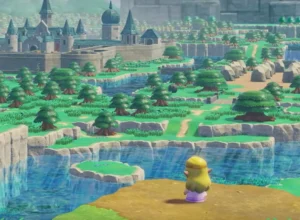Grab your white gown, wide-brimmed hat and Freddy Krueger gardening glove – it’s time to sample the delights of Resident Evil Village.
Capcom has always strived to try new things with each mainline iteration of Resident Evil. From the claustrophobic, fixed camera perspectives of the original game’s Spencer Mansion to the first-person frights in Resident Evil 7: Biohazard’s swamps, the franchise’s strongest asset has always been its willingness to reinvent itself.
Never is that more apparent than in Resident Evil Village. A lot of the discourse surrounding the eighth iteration of the seminal series has been focused on defining exactly what kind of game it will be – well, that and fantasising about Lady Dimitrescu. Some have speculated it’ll be a spiritual successor to Resident Evil 4; others, an evolution of Resident Evil 7.
But as you traverse Resident Evil Village’s thrilling 10-hour campaign, it becomes clear it’s a harmonious marriage between both. Much like how Biohazard was a fresh take on the philosophies of the first Resident Evil, Village feels like a fresh take on the philosophies of Resident Evil 4.
The end result is a sensational slice of triple-A horror and another bold step for Resident Evil, exploring adventurous new ideas while continuing to offer all the mutated monsters and B-movie horror cheese that make the series so charming.
Fresh off fighting zombified ranchers in the Louisiana bayou, Resident Evil Village picks up the story of returning protagonist Ethan Winters, who’s moved to Europe with his wife and daughter. It doesn’t take long for the family’s idyllic life to take a sinister turn, as Chris Redfield violently breaches Ethan’s home, kidnaps his daughter, and leaves him for dead. It’s a shocking opening that sets up quite the intriguing mystery, and although the answers to the tale’s biggest enigmas ultimately fall flat, the journey to them is loaded with remarkable aspects.

The commitment to Biohazard’s brand of atmospheric horror is definitely among them. During the game’s first hour alone, Ethan’s forced to navigate creepy forests, investigate not-so-abandoned buildings, and sneak through the titular village’s eerie rural streets. Much like its predecessor, the first-person perspective, immersive audio design and haunting environments make these moments some of Resident Evil’s creepiest to date.
Unfortunately, one of the less exciting things to carry over is Ethan himself, who still has about as much personality as a zombie. Luckily, his new home doesn’t share this problem. Previous entries in the series have often relied on backtracking, which treads a fine line between satisfying and uninspired. However, Village tries something new with the concept, turning its core location into an aesthetically rich and unsettling hub that players can plunder for optional resources, weapons, and treasures.
There’s even a moment where players can use the area to decide which boss they want to tackle next, which is a phenomenal idea and one I actually wish Resident Evil Village had used more.
But the best thing about the hub is that it offers open-ended exploration while still allowing Resident Evil Village to spin its set pieces into more linear, spectacle-heavy encounters. Without spoiling things, Ethan’s quest to rescue his daughter eventually sees him square up against a roster of scenery-chewing villains. These “lords” quickly become Ethan’s main obstacles throughout the game, as he’s forced to pursue them to their individual bases.
Not only do these segments stand as diverse, fast-paced and outrageously entertaining slices of action, but the roster of theatrical villains are some of my favourite Resident Evil baddies to date. They’re so good that they completely overshadow the main antagonist, who pales in comparison to their more eccentric subordinates.
Each villain’s area relies on a different style of gameplay, whether that’s horror, combat, puzzles, or a particular mix of the three. The now infamous Lady Dimitrescu, for example, features in one of the meatier sequences, with her ominous castle feeling akin to Resident Evil 2’s infamous police precinct.


Much like the claustrophobic building, there are adventure-game-style puzzles to solve, items that unlock new areas, and, of course, the eternally present force of the giant vampire herself, who relentlessly stalks you like an elegant Mr. X. The pacing of the sequence guarantees it’s a fun and familiar call back to Resident Evil’s past without turning into a tired trope.
Before it gets stale, then, Resident Evil Village whisks you along to the next grand set-piece, acting more like a terrifying roller coaster than the methodical haunted house that was Biohazard. A lot of that pace comes from the new focus on combat. This time around, Capcom has finally managed to strike the perfect balance between fights and frights. Scraps with enemies are tense, frantic affairs thanks to the sluggish first-person camera, and although large-scale battles are more common this time around, the game still limits resources to ensure you feel vulnerable.
As for the mechanics themselves, there are several significant changes. Players can block more tactically, pushing back attackers who get too close, while there are several new weapons to play around with. In a callback to Resident Evil 4, a merchant known as the Duke – alongside being a fascinating figure in his own right – can sell players gun parts, blueprints, and other additions to their arsenal. One of his main services even tasks players with hunting local wildlife to upgrade their stats, which adds a distinctly Far Cry flavour to exploration.
The biggest new additions to combat are the enemies though. From standard werewolves and shambling, sword-wielding husks to spectacle-heavy boss encounters, the sequel comes loaded with new threats to face. It’s a welcome change following Biohazard’s limited variations of the Molded, even if the nightmarish foes provide little challenge once the player gets their hands on a few good weapons.



All in all, this is an outstanding sequel. Over the last few years, Capcom has really homed in on what fans want, and Resident Evil Village feels like the culmination of that experimental drive. Its setting is wonderfully weird and wholly different from prior entries, while its set-pieces gracefully weave between intense action and effective horror while ensuring both get ample time to breathe.
Partner that with stunning visuals, entertaining villains and an interesting structure, and you’ve got yourself a phenomenal horror experience. It’s great to see the franchise enjoying a second wind right now and Village makes it very clear that Resi isn’t ready to hang up its hat just yet.
Game: Resident Evil Village
Platforms: PlayStation 5 (reviewed), PlayStation 4, Xbox Series X|S, Xbox One, PC, Google Stadia
Publisher: Capcom
Developer: Capcom
Release Date: May 7, 2021






